吉林大学学报(医学版) ›› 2023, Vol. 49 ›› Issue (4): 1027-1033.doi: 10.13481/j.1671-587X.20230425
• 临床研究 • 上一篇
不同部位微种植体辅助隐形矫治器远移下颌磨牙的三维有限元分析
- 吉林大学口腔医院正畸科,吉林 长春 130021
Three-dimensional finite element analysis on micro-implant-assisted invisible orthodontic appliance in different parts in remote displacement of mandibular molars
Fujia KANG,Yunyun SUN,Han ZHANG,Kepeng ZHANG,Hanyi LI,Songqing WANG,Xianchun ZHU( )
)
- Department of Orthodontics,Stomatology Hospital,Jilin University,Changchun 130021,China
摘要:
目的 应用有限元分析法探讨微种植体植入不同部位时辅助隐形矫治器远移下颌磨牙的生物力学效应,以确定微种植体植入部位的最优方案。 方法 获取1例成年男性安氏Ⅲ类错 畸形患者锥形束计算机断层扫描(CBCT)数据,使用Mimics Medical和3-Matic建模软件建立隐形矫治器远移下颌磨牙的三维有限元模型,依据是否使用微种植体分为对照组(无微种植体,工况一)和3个实验组[下颌第一与第二前磨牙根间微种植体组(工况二)、下颌第二前磨牙与第一磨牙根间微种植体组(工况三)及下颌第一与二磨牙根间微种植体组(工况四)]。在Ansys Workbench有限元分析软件中对各组模型以0.2 mm的步距远中移动下颌第二磨牙,施加自微种植体至隐形矫治器每侧2 N的牵引力辅助磨牙远移,分析各工况牙齿位移趋势、隐形矫治器形变特点和Von Mises等效应力云图。 结果 拟矫治牙的远中移动量和压低移动量均为工况四>工况三>工况二>工况一,其中工况四下颌第二磨牙远中移动量为0.188 mm。支抗牙在工况一中表现为近中和唇向移动的位移趋势,在实验组各工况中表现为向远中和舌侧的移动趋势,其移动量为工况四>工况三>工况二。初戴时矫治器第一磨牙和第二磨牙间挤压形变量最大,应力峰值为192.15 Mpa。应力释放后,对照组应力集中现象仍位于矫治器第一磨牙和第二磨牙间,实验组应力集中现象位于矫治器尖牙唇面,其中工况四应力峰值为56.48 Mpa。 结论 使用微种植体支抗辅助下颌磨牙远移可增加磨牙远移量,减少前牙支抗丢失。植入部位越靠后,产生的磨牙远移压低效应越明显,隐形矫治器牙齿移动实现率越高。
畸形患者锥形束计算机断层扫描(CBCT)数据,使用Mimics Medical和3-Matic建模软件建立隐形矫治器远移下颌磨牙的三维有限元模型,依据是否使用微种植体分为对照组(无微种植体,工况一)和3个实验组[下颌第一与第二前磨牙根间微种植体组(工况二)、下颌第二前磨牙与第一磨牙根间微种植体组(工况三)及下颌第一与二磨牙根间微种植体组(工况四)]。在Ansys Workbench有限元分析软件中对各组模型以0.2 mm的步距远中移动下颌第二磨牙,施加自微种植体至隐形矫治器每侧2 N的牵引力辅助磨牙远移,分析各工况牙齿位移趋势、隐形矫治器形变特点和Von Mises等效应力云图。 结果 拟矫治牙的远中移动量和压低移动量均为工况四>工况三>工况二>工况一,其中工况四下颌第二磨牙远中移动量为0.188 mm。支抗牙在工况一中表现为近中和唇向移动的位移趋势,在实验组各工况中表现为向远中和舌侧的移动趋势,其移动量为工况四>工况三>工况二。初戴时矫治器第一磨牙和第二磨牙间挤压形变量最大,应力峰值为192.15 Mpa。应力释放后,对照组应力集中现象仍位于矫治器第一磨牙和第二磨牙间,实验组应力集中现象位于矫治器尖牙唇面,其中工况四应力峰值为56.48 Mpa。 结论 使用微种植体支抗辅助下颌磨牙远移可增加磨牙远移量,减少前牙支抗丢失。植入部位越靠后,产生的磨牙远移压低效应越明显,隐形矫治器牙齿移动实现率越高。
中图分类号:
- R783.5
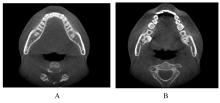

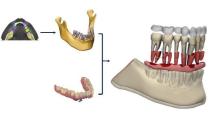





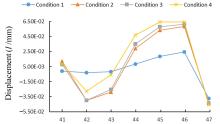

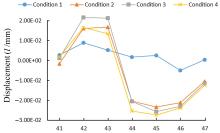

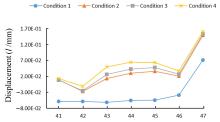

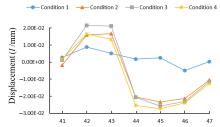

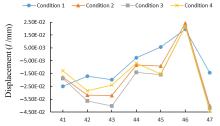

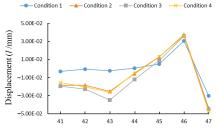

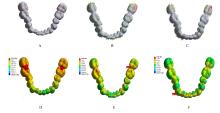

 畸形的研究现状[J]. 现代口腔医学杂志, 2015, 29(1): 52-55.
畸形的研究现状[J]. 现代口腔医学杂志, 2015, 29(1): 52-55.